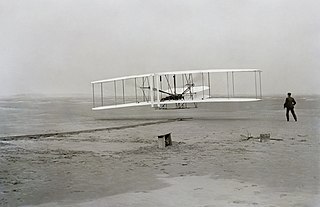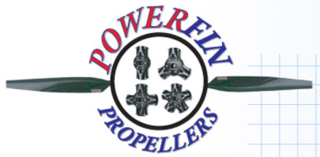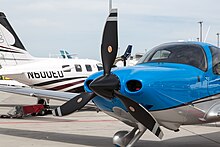
The Pitts Special is a series of light aerobatic biplanes designed by Curtis Pitts. It has accumulated many competition wins since its first flight in 1944. The Pitts biplanes dominated world aerobatic competition in the 1960s and 1970s and, even today, remain potent competition aircraft in the lower categories.

The Wright Flyer made the first sustained flight by a manned heavier-than-air powered and controlled aircraft—an airplane—on December 17, 1903. Invented and flown by brothers Orville and Wilbur Wright, it marked the beginning of the pioneer era of aviation.

Aeronca, contracted from Aeronautical Corporation of America, located in Middletown, Ohio, is a US manufacturer of engine components and airframe structures for commercial aviation and the defense industry, and a former aircraft manufacturer. From 1928 to 1951, the company was a major producer of general aviation aircraft, and also produced the engines for some of their early designs.

Dayton Aviation Heritage National Historical Park is a United States National Historical Park in Dayton, Ohio that commemorates three important historical figures—Wilbur Wright, Orville Wright, and poet Paul Laurence Dunbar—and their work in the Miami Valley.

MT-Propeller Entwicklung GmbH, founded in 1980 by Gerd Muehlbauer, is a manufacturer of composite propellers for single and twin engine aircraft, airships, wind tunnels and other special applications.

Hoffman Propeller is a German manufacturer of aircraft propellers. The company headquarters is located at Rosenheim in Bavaria, Germany. The company makes design, manufacture and maintain propellers with blades in wooden composite construction for needed purposes, mainly for the general aviation, hovercraft and any special applications such as blades for wind tunnels the automotive industries. By the version of Aircraft Turboprop Propeller System Market Outlook, the company was one of the major market players.
AKS Inc, was an American manufacturer of composite aircraft propellers. The company was based in Portland Oregon

Competition Aircraft Inc, founded in 1980 by Jack Venaleck, is an American manufacturer of composite propellers for ultralight aircraft. The company headquarters is located in Grass Valley, California.
McCauley Propeller Systems is an American aircraft propeller manufacturer, founded in Dayton, Ohio in 1938 by Ernest G. McCauley. At its peak, it was reportedly the world's largest aircraft propeller manufacturer, or at least the largest manufacturer of general aviation propellers. For most of its existence, McCauley was headquartered in or near Dayton. In the 21st century, its headquarters were moved to then-parent-company Textron Aviation's headquarters in Wichita, Kansas.
Prince Aircraft Company, founded in 1979 by Lonnie Prince, is an American manufacturer of wood and composite propellers for homebuilt and ultralight aircraft. The company headquarters is located in Whitehouse, Ohio.
Props Inc, founded in 1985 by Jeff Bertuleit, is an American manufacturer of wooden propellers for homebuilt and ultralight aircraft. The company headquarters is located in Newport, Oregon.

Sensenich Propeller, founded in 1932, is an American manufacturer of wood, metal and composite propellers for certified, homebuilt and ultralight aircraft, and unmanned aerial vehicles, as well as airboats. The company headquarters is located in Lititz, Pennsylvania.

Powerfin Propellers, is an American manufacturer of composite propellers for homebuilt, light-sport and ultralight aircraft, as well as wind power generation systems. The company headquarters is located in Hurricane, Utah, although it was formerly in El Campo, Texas and originated in Arlington, Washington.

The Vidor Champion V is an Italian homebuilt aircraft that was designed by Giuseppe Vidor, first flying on 10 June 1995. The aircraft is supplied in the form of plans for amateur construction. It is also known as the Asso Aerei V Champion.

The Stewart S-51D Mustang is an American aerobatic homebuilt aircraft that was designed by Jim Stewart and produced by Stewart 51 of Vero Beach, Florida, introduced in 1994. When it was available the aircraft was supplied as a kit for amateur construction.

The Bede BD-14 was an American homebuilt aircraft, designed by Jim Bede and produced by Bede Aircraft of Medina, Ohio, introduced in the 1990s. The aircraft was intended to be supplied as a kit for amateur construction, but only one was ever built.
Robert Norris Hartzell was an American entrepreneur who started Hartzell Propeller in 1917, a company that produces aircraft propellers.
The Lancair Sentry is an American amateur-built aircraft that was designed and produced by Lancair of Redmond, Oregon, introduced in 2002. The aircraft was supplied as a kit for amateur construction, although it was also intended as a production military trainer aircraft. First flown in September 2001, only two were ever completed.
The National Advanced Air Mobility Center of Excellence is a research facility dedicated to studying air mobility and Unmanned Aircraft Systems (UAS). It contains 30,000 square feet of administrative, laboratory, meeting, and collaboration space with an additional 25,000 square feet of aircraft hangar space. The facility is located at the Springfield–Beckley Municipal Airport, which is close by to Wright-Patterson Air Force Base.














